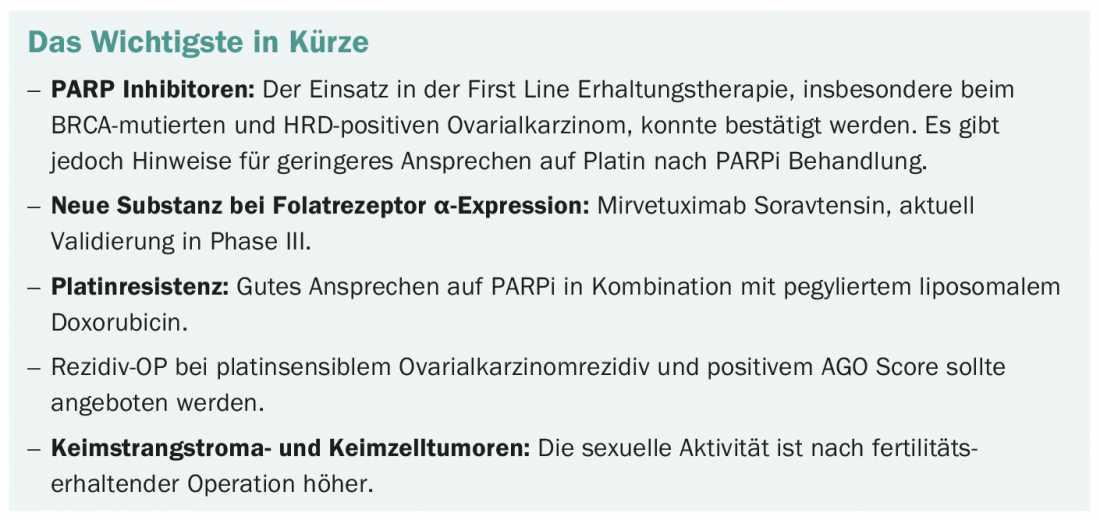The treatment of ovarian cancer is in a constant state of flux with the ongoing development of new drugs such as PARP inhibitors. With increasing experience in the use of these substances, highly topical questions arise such as those concerning possible combination and follow-up therapies. Research is also ongoing regarding the optimal surgical method for ovarian tumors, their indications and effects.
Initial long-term data on PARP inhibitor therapy presented at ESMO Congress 2020 paint a very promising picture. For example, in platinum-sensitive ovarian cancer, after 2 years of maintenance therapy with olaparib in the first-line setting, median progression-free survival remains high after 5 years. In the most recent data from the SOLO1 trial, this was 56 months for patients with BRCA mutation receiving PARPi treatment, compared with a meager 13.9 months in the placebo group [1]. Analysis of side effects showed increased anemia and nausea, but the original fear that myelodysplastic syndromes or acute myeloid leukemia might occur did not materialize. With dosage adjustment, overall adverse drug reactions were well controlled. Thus, initial longer-term data suggest maintenance therapy with a PARP inhibitor for patients with high-grade serous ovarian cancer and BRCA ½ mutation in the first-line setting.
Studies including patients without BRCA mutation also demonstrated a survival benefit with PARPi therapy, albeit smaller[2–4]. Here, the homologous recombination deficiency (HRD) appears to be status to be a determining factor for the success of treatment [3], however, even without positive HRD status, niraparib maintenance therapy showed a longer PFS [4].
The price of success
The resounding success of PARP inhibitors in the treatment of primary platinum-sensitive ovarian cancer is somewhat overshadowed by the detriment of subsequent lines of therapy. Thus, the use of PARPi has been shown to alter platinum sensitivity and decrease response to repeated platinum-based chemotherapy [5,6]. With proven better overall survival, this should not lead to a reduction in the use of PARP inhibitors, but does raise the question of optimal follow-up therapy.
Although there is certainly much need for research in this area, the new agent mirvetuximab soravtansine (MIRV) may be a promising approach [7]. This antibody-drug conjugate (ADC) consists of a folate receptor α (FRα)-binding antibody and maytansinoid DM4, a substance with activity on tubulin. FRα is expressed by many tumor cells, including ovarian cancer, endometrial cancer, and NSCLC. A single-arm phase II trial demonstrated the efficacy of MIRV in combination with carboplatin and bevacizumab in FRα-positive, platinum-sensitive ovarian cancer recurrences [7]. In order to further test the use of the new substance, the 2 clinical studies MIRASOL and MIROVA are currently ongoing.
And what to do in platinum-resistant ovarian cancer?
Since PARP inhibitors alone are not suitable for maintenance therapy in platinum resistance, the search for alternatives for affected patients is ongoing. Results of a phase II trial evaluating the combination of olaparib and pegylated liposomal doxorubicin in platinum-resistant ovarian cancer were presented at this year’s ESMO Congress [8]. The known potentiation of side effects was also observed in this study. However, after appropriate dose adjustment, remission rates around 30% and with respect to PFS and overall survival results were shown, which argue for further investigation of the combination of PARPi- and chemotherapy.
News from the surgical side
Researchers were also not idle in 2020 regarding surgical indications and sequelae for ovarian tumors. Recent data clearly support secondary cytoreductive surgery in patients with platinum-sensitive ovarian cancer recurrence [9]. In the DESKTOP III trial, this measure prolonged PFS by 5.6 months and overall survival by as much as 7.7 months compared to chemotherapy alone. However, this impressive improvement was limited to the subgroup in which complete tumor removal was achieved. PFS with incomplete resection was comparable to that with chemotherapy alone, so incomplete tumor removal did not worsen prognosis. The bottom line, according to these new findings, is that recurrent surgery should be offered for platinum-sensitive ovarian cancer and a positive AGO score.
Data on quality of life and sexuality after different surgical procedures were also presented at this year’s ESMO congress and are highly relevant for patients and their education [10]. Surgeries for germ cell and stromal tumors of the ovary, which predominantly affect young women, were studied. Overall, the proportion of sexually active patients was relatively low at 54%. Strikingly, sexual activity was significantly higher after fertility-preserving surgery, although no differences were recorded in the area of sexual satisfaction among the sexually active collective. Whether women who place a higher value on their sexuality are more likely to opt for fertility-preserving surgery or the surgical procedure influences sexual activity cannot be distinguished from the available data. Nevertheless, these results shed light on an often neglected aspect in the choice of therapy.
Source: ESMO 2020 Virtual
Literature:
- Banerjee S, et al: Maintenance olaparib for patients (pts) with newly diagnosed, advanced ovarian cancer (OC) and a BRCA mutation (BRCAm): 5-year (y) follow-up (f/u) from SOLO1. Annals of Oncology 2020; 31(suppl_4): 551-589.
- Mirza MR, et al: The forefront of ovarian cancer therapy: update on PARP inhibitors. Ann Oncol. 2020; 31(9): 1148-1159.
- Ray-Coquard I, et al: Olaparib plus bevacizumab as first-line maintenance in ovarian cancer. N Engl J Med. 2019; 381(25): 2416-2428.
- González-Martín A, et al: Niraparib in Patients with Newly Diagnosed Advanced Ovarian Cancer. N Engl J Med. 2019; 381(25): 2391-2402.
- Baert T, et al: Expected versus observed response to platinum-based chemotherapy after poly (ADP-ribose) polymerase inhibitor treatment for relapsed ovarian cancer. Annals of Oncology 2020; 31(suppl_4): 551-589.
- Frenel J, et al: Efficacy of subsequent chemotherapy for patients with BRCA1/2 mutated platinum-sensitive recurrent epithelial ovarian cancer (EOC) progressing on olaparib vs placebo: The SOLO2/ENGOT Ov-21 trial. Ann Oncol. 2020; 31(suppl_4): 551-589.
- O’Malley DM, et al: Mirvetuximab soravtansine (MIRV), a folate receptor alpha (FRα)-targeting antibody-drug conjugate (ADC), in combination with carboplatin (CARBO) and bevacizumab (BEV): final results from a study in patients (pts) with recurrent platinum sensitive ovarian cancer. Annals of Oncology 2020; 31(suppl_4): 551-589.
- Perez-Fidalgo JA, et al: GEICO1601-ROLANDO: a multicentric single arm phase II clinical trial to evaluate the combination of olaparib and pegylated liposomal doxorubicin for platinum-resistant ovarian cancer. Future science OA. 2019; 5(2): FSO370-FSO.
- Bois AD, et al: Randomized phase III study to evaluate the impact of secondary cytoreductive surgery in recurrent ovarian cancer: final analysis of AGO DESKTOP III/ENGOT-ov20. Journal of Clinical Oncology 2020; 38(15_suppl): 6000.
- Hasenburg A, et al: The effect of surgical techniques on sexuality and global quality of life (Qol) in women with ovarian germ cell (OGCT) and sex cord stromal tumours (SCST): An analysis of the AGO-CORSETT database. Annals of Oncology 2020; 31 (suppl_4): 551-589.
InFo ONCOLOGY & HEMATOLOGY 2020; 8(5): 32-33.












